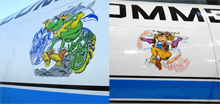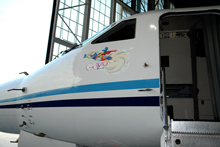Kermit the Frog, Miss Piggy, and Gonzo* Go Flying with NOAA's Hurricane Hunter Aircraft
*(Muppet characters are copyrighted by Jim Henson Productions)
To carry out its mission, NOAA maintains a fleet of aircraft to acquire data on the atmosphere, environment, and geography. These aircraft conduct various missions such as flying into hurricanes and winter storms to determine their intensity and direction; conducting air quality studies; surveying snow pack for hydrologic forecasting, marine mammals and fish for resource assessments, and changing coastlines for cartography; and undertaking remote sensing and aerial photography projects. The fleet is managed by NOAA's Office of Marine and Aviation Operations Aircraft Operations Center, which is located at MacDill Air Force Base in Tampa, Florida.

Kermit, Miss Piggy, and Gonzo grace the nose of several NOAA hurricane hunter aircraft. Copyright © The Jim Henson Company. Click image for larger view.
During hurricane season, NOAA’s hurricane research and surveillance aircraft—two WP-3D Orion turboprop airplanes and one Gulfstream-IV (G-IV) jet—are very visible and critical tools in NOAA’s forecasting arsenal.
Those who have seen pictures of the aircraft or the aircraft itself may have noted that the noses on both WP-3D Orions and the G-IV jet sport either Kermit the Frog, Miss Piggy, or Gonzo. Greg Bast, Production Controller and Flight Engineer at NOAA’s Aircraft Operations Center, Aircraft Maintenance Branch, gives the inside story on why the Muppets fly with NOAA.
Meet the Muppets
When I came on board with NOAA’s Office of Aircraft Operations (now called the Aircraft Operations Center) 14 years ago, I was assigned as crew chief of the WP-3D Orion, N43RF, Hurricane Hunter. The former mechanic on the P-3 was a good mechanic, but was not into the cosmetic appearance of the aircraft. Around the maintenance operations department, the aircraft was referred to as the “pig.” At that time, a new Flight Engineer, Steve Kirkpatrick, was also assigned to the P-3. Neither of us was happy with the appearance of the aircraft and set out to change it over the next year. We also decided to start calling it “Miss Piggy,” because the Muppet character is always so fastidious with her appearance.
As I am a frustrated artist at heart, I drew up a logo using the Miss Piggy Muppet character. Steve and I used the logo inside the P-3, on our tool boxes, by our desks, etc. The name caught on around the Center and “Miss Piggy” became one of the nicest looking aircraft we had.
One of our pilots, CDR Ron Phillipsborn (now retired), came up with the idea of contacting Henson Productions to see if they might want to do anything with some of our ideas. Henson was thrilled with the idea and talked with their public relations people about it. Mr. Michael Frith, Director of Muppet Productions at the time, contacted me to talk about what kind of art we were looking for. We discussed the subject at length, and came up with the idea of using something similar to the World War II nose art that was painted on the aircraft of the time. He also asked me to send him what I had drawn. Michael came up with the idea of using Kermit on the other P-3, as Kermit and Miss Piggy are such good friends and the two aircraft are very close.
Approximately six months later, Michael sent us two proofs to look at. They were exactly what we were looking for, and those proofs were used to make the large logos that appear on the aircraft today. This all took place in the late-1990 to early-1991 time frame.
When the first logos were put on the aircraft, we had a formal unveiling at our facility in Miami. Henson Productions had several people there, including Michael Frith, who did the actual unveiling of the logos.
When we acquired the G-IV in 1996, we asked Henson Productions if they would again be willing to do some artwork for us. The character of Gonzo was chosen because of the non-standard nose radome that is installed on the G-IV. Again, Henson Productions was delighted to help us out and came up with the artwork that now appears on the aircraft.
This is the true and full story of the logos. Although the birth of these logos was somewhat ‘tongue in cheek,’ the Aircraft Operations Center has used the logos to pique the interest of children of all ages, around the country and the world, in atmospheric research. We hand out small replica logo stickers to all of the kids (and adults) who visit our facility and aircraft. The logos always draw attention to our aircraft everywhere we go.

Miss Piggy and Kermit continue to add a light touch to the important work conducted by NOAA. Click image for larger view.
Henson Productions has been very kind to us, and we are very proud to have these logos on the side of our aircraft. The logos have put some fun into what we do and enhanced our visibility to the public. The nicknames for the aircraft have become such a big part of our tradition around the Aircraft Operations Center that the aircraft are seldom referred to by their registration numbers any more.
NOAA’s WP-3Ds and Gulfstream GIV-SP high altitude research aircraft and the Air Force’s WC-130 aircraft fly directly into hurricanes, collecting valuable data that is helping hurricane forecasting to become more of an exact science. In the past seven years, the hurricane landfall error forecast has dropped from 450 miles of coastline to approximately 150 miles of coastline. At an estimated cost in excess of $1 million dollars per mile to activate emergency services, the intangible savings to the American public have been substantial. While we will never be able to prevent hurricanes from making landfall along the coastlines of the United States, with new technology and increased databases, improved forecasting will give America’s coastal residents the time needed to safely evacuate the predicted landfall area, minimizing loss of life and property.
Contributed by Greg Bast, NOAA's Office of Marine and Aviation Operations

